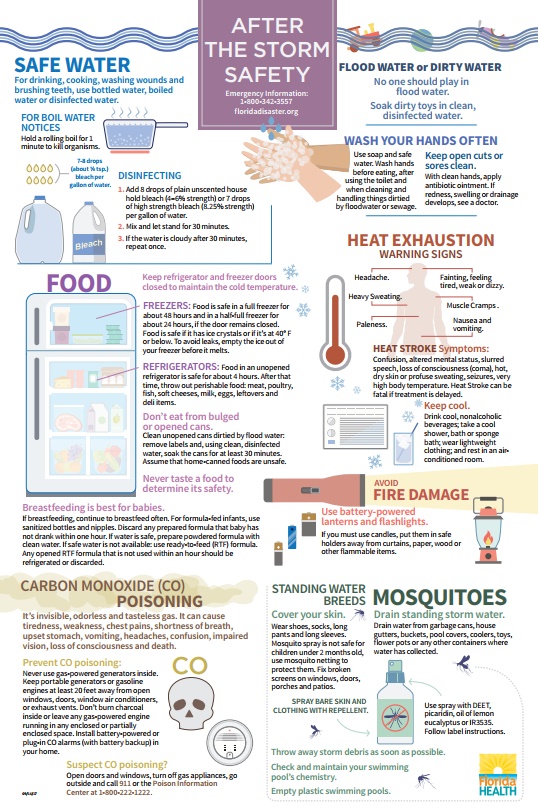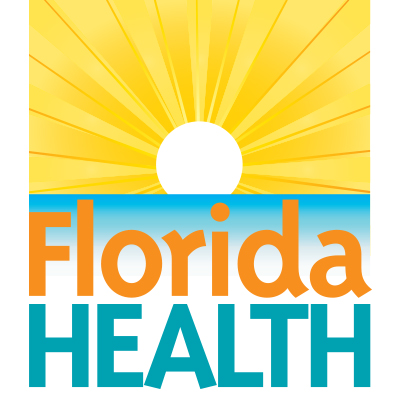Take Action to Minimize Mold and Dampness in Water-Damaged Buildings

MONROE COUNTY, FL— The Florida Department of Health in Monroe County urges the public to take precautionary measures to avoid indoor air quality problems can that occur in storm damaged homes and buildings. Moisture from leaks or flooding can promote mold growth inside buildings. Mold can cause disease, trigger allergic reactions, and continue to damage materials long after the storm. Failure to control moisture and mold can present short and long-term health risks.
TIPS TO CLEAN UP MOLD AND PROTECT YOUR HEALTH
- Protect yourself: Put on personal protective equipment (cleaning type gloves, N95 respirator/mask, and safety goggles) to protect your skin, mouth, nose, lungs and eyes. Individuals with known mold allergies or asthma should not clean or remove moldy materials.
- Toss / Take it out: Anything that was wet with flood water and can’t be cleaned and dried completely within 24 to 48 hours should be taken outside. Take photos of discarded items for filing insurance claims.
- Air out: Open all doors and windows when you are removing wet or moldy materials, or cleaning moldy surfaces.
- Drying it out: When electricity is safe to use, you can close doors/windows and use fans and dehumidifiers to help remove moisture indoors. Remember that dehumidifiers can only dehumidify under closed indoor conditions. Dry your home and everything in it as quickly as possible. In addition, remove standing water from your home or office, which can also prevent mosquitoes from breeding.
- Don’t mix cleaners: If you use cleaning products, do not mix cleaning products together because doing so can create toxic vapors; This includes ammonia cleaners and acids as dangerous gases can form. Make sure you read and follow label instructions carefully and open windows and doors to provide plenty of fresh air.
- Scrub surfaces: Clean with water and detergent. Remove all mold you can see. Dry right away.
- Don’t cover it, remove it: Painting or caulking over mold will not prevent mold from growing. Fix the water problem completely, dry it out, and clean up all the mold before you paint or caulk.
- Consider your medical status: Individuals with suppressed or impaired immune systems, mold allergies, asthma, or other chronic lung disease should not clean or remove moldy materials. See your doctor if you are unsure of your medical status or are not feeling well.
- Prevent carbon monoxide poisoning: Never use gasoline or propane powered tools or generators indoors as these devices produce very hazardous carbon monoxide which can kill you within minutes. If you are using a generator, please place it at least 20 feet from all buildings. Install a battery operated carbon monoxide alarm in your home.
For more information about indoor air quality and mold growth, visit www.floridahealth.gov/indoorair. A handy guide for cleaning mold from flooded homes is available at: https://www.epa.gov/indoor-air-quality-iaq/flood-cleanup-protect-indoor-air-quality. Population-specific recommendations for protection from exposure to mold in flooded buildings by specific activity and risk factor is available from the Centers for Disease Control and Prevention at: https://www.cdc.gov/disasters/mold/report/pdf/2005_ moldtable5.pdf.
For more information about suspected carbon monoxide poisoning emergencies, call the Florida Poison Information Center at 1-800-222-1222. To learn more about carbon monoxide poisoning prevention, visit www.floridahealth.gov/environmental-health/carbon-monoxide/index.html or call the Florida Emergency Information Line 24/7 at 1-800-342-3557 or the Radon and Indoor Air Program at 1-800-543-8279.
~~~~~~~~~
About the Florida Department of Health
The department, nationally accredited by the Public Health Accreditation Board, works to protect, promote and improve the health of all people in Florida through integrated state, county and community efforts.
Follow us on Twitter at @HealthyFla and on Facebook. For more information about the Florida Department of Health please visit www.FloridaHealth.gov


